 That would be farro! I hadn't, but I've seen many recipes that call for the grain and I've kept my eye out in the markets around here to find it. I did finally notice a bag at Whole Foods a few months ago and was tempted to pick it up, but it was a bit spendy for such a little amount. However, while browsing the loaded isles of Costco a couple weeks ago, guess what I found? Yep, a mighty big bag of farro that didn't make my heart skip a beat when looking at the price tag!
That would be farro! I hadn't, but I've seen many recipes that call for the grain and I've kept my eye out in the markets around here to find it. I did finally notice a bag at Whole Foods a few months ago and was tempted to pick it up, but it was a bit spendy for such a little amount. However, while browsing the loaded isles of Costco a couple weeks ago, guess what I found? Yep, a mighty big bag of farro that didn't make my heart skip a beat when looking at the price tag!Farro is a type of wheat, emmer wheat (though some claim it is the same as spelt), that has a texture reminiscent of barley or wheat berries - when cooked, it is toothsome, chewy and quite nutty with a delicate sweetness. The type we bought and used in the Chicken, Corn, Edamame and Farro Salad with Goat Cheese dish we made is labeled "semi-pearled", which cooks in about half the time of whole farro. However, do note that it is slightly less nutritous as part (or all) of the hull is removed - whole farro would take at least 45 minutes to an hour to cook, if soaked first. So, there is a trade off for a grain that cooks in a fraction of the time. For what it's worth, even though I've only seen farro twice, it has only been in this semi-pearled form.
 After cooking the farro in plenty of salted water, we took the plump grains and tossed them with sautéed cubes of chicken breast, brilliant corn kernels (thawed corn we stashed in the freezer from the last fresh batch we bought at the farmers' market last summer), edamame and plenty of sliced green onions. The original recipe did call for blanched green beans, but I can't say that's a bean either of us are all that fond of - edamame has been an honorable stand-in for us. If you do happen to groove on those crisp beans, use about 12 ounces or so, cook them just until crisp-tender and then shock them in icy water.
After cooking the farro in plenty of salted water, we took the plump grains and tossed them with sautéed cubes of chicken breast, brilliant corn kernels (thawed corn we stashed in the freezer from the last fresh batch we bought at the farmers' market last summer), edamame and plenty of sliced green onions. The original recipe did call for blanched green beans, but I can't say that's a bean either of us are all that fond of - edamame has been an honorable stand-in for us. If you do happen to groove on those crisp beans, use about 12 ounces or so, cook them just until crisp-tender and then shock them in icy water.This vibrant salad now needed a zesty dressing to match, which was created by whisking together good quality extra-virgin olive oil, fresh marjorm (oregano would also work well, maybe with a pinch of tarragon for good measure), white wine vinegar, a scoop of minced shallot and a dollop of Dijon mustard to bring those ingredients together. Just before serving, we topped each portion with crumbles of goat cheese for a rich, tangy finish.
 Because I wasn't going to have time this evening, I prepared the salad early in the morning and kept it chilled until dinnertime. I would do that again as found it to have a bit more cohesive flavor after the stint in the refrigerator - saying that, even after tasting right after tossing the salad together, I thought it was worthy of being made again. Jeff mentioned afterward that he thought this would be an excellent salad to bring on a picnic this summer (that is, if it ever warms up again!).
Because I wasn't going to have time this evening, I prepared the salad early in the morning and kept it chilled until dinnertime. I would do that again as found it to have a bit more cohesive flavor after the stint in the refrigerator - saying that, even after tasting right after tossing the salad together, I thought it was worthy of being made again. Jeff mentioned afterward that he thought this would be an excellent salad to bring on a picnic this summer (that is, if it ever warms up again!).Recipes
























































